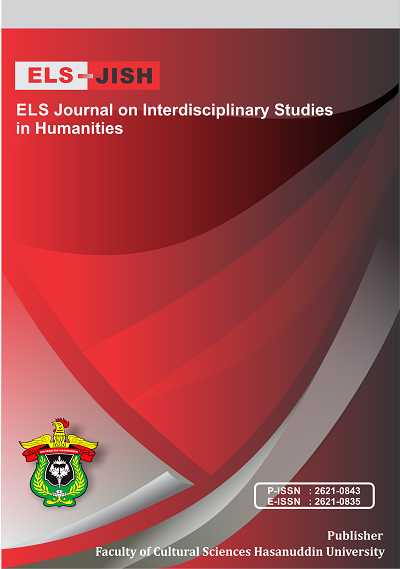Symbolic Violence against Women in Cho Nam Joo’s Kim Ji Young Born 1982
DOI:
https://doi.org/10.34050/elsjish.v5i3.21677Keywords:
Censorship, Euphemism, Mechanism, Symbolic ViolenceAbstract
This study aims to identify the forms of symbolic violence experienced by the character named Kim Jiyoung and other female characters in the Kim Jiyoung Born 1982 novel by Cho Nam Joo using symbolic violence theory in the mechanism of euphemism and censorship. Euphemism is a mechanism by hiding the intent of violence that works subtly and unconsciously. Meanwhile, censorship is a mechanism that makes symbolic violence a value preserved and considered absolute. This study employed a descriptive qualitative method to understand the symbolic violence phenomenon contained in the novel. The data collection technique was carried out using close reading technique. The data were taken from dialogue and narrations related to the symbolic violence issues. The results of this study revealed that the symbolic violence experienced by Kim Jiyoung and other female characters occurs in the domestic and public sphere. The euphemism mechanisms showed that symbolic violence occurs through concern, labeling, insistence, prohibition, subtle rejection, belief, and giving permission. Meanwhile, censorships were in the form of marginalization in culture, women's role, generosity, and unequal division of labor.
References
Arianto, T. (2018). Symbolic Violence Against Women in Sepasang Mata Dinaya Yang Terpenjara Short Story By Ni Komang Ariani. KREDO : Jurnal Ilmiah Bahasa Dan Sastra, 2(1), 53–64. https://doi.org/10.24176/kredo.v2i1.2526
Bourdieu, P. (1991). Language and Symbolic Power. In Harvard University Press. Harvard University Press. https://doi.org/10.2307/3685295
Bourdieu, P. (1998). ‘Masculine Domination.’ In Critique of Anthropology. Stanford University Press. https://doi.org/10.1177/0308275x09104082
Bourdieu, P. (2013). Outline of A Theory of Practice. Cambridge University Press.
Burawoy, M. (2019). Symbolic Violence Conversations with Bourdieu. In Duke University Press. Duke University Press.
Cho, Y., Kim, S., You, J., Han, H., & Kim, M. (2021). How South Korean women leaders respond to their token status : assimilation and resistance How South Korean women leaders respond to their token status : assimilation and resistance. Human Resource Development International, 1–24. https://doi.org/10.1080/13678868.2021.1885207
Choi, E. J., & Hwang, J. (2020). Transition of Son Preference: Evidence From South Korea. Springer, 57(2), 627–652. https://doi.org/10.1007/s13524-020-00863-x
Damayanti, G., Andarwulan, T., & Aswadi, A. (2019). Mekanisme Eufemisme Dan Sensorisasi: Kekerasan Simbolik Dalam Tuturan Dosen. RETORIKA: Jurnal Bahasa, Sastra, Dan Pengajarannya, 12(2), 223. https://doi.org/10.26858/retorika.v12i2.9101
Edwards, L., Roces, M., Hampson, S., Chan, J., Stivens, M., & Robinson, K. (2000). Women in Asia: Tradition, modernity and globalisation. In Allen&Unwin. Allen&Unwin.
Fakih, M. (2013). Analisis Gender dan Transformasi Sosial. Yogyakarta: Pustaka Pelajar.
Faruk, H. (2012). Pengantar Sosiologi Sastra : Dari Strukturalisme Genetik Sampai Post-Modernisme. Yogyakarta: Indonesia: Pustaka Pelajar.
Foucault, M. (1971). The Order of Discourse. In Routledge (Vol. 10). Routledge & Kegan Paul Ltd. https://doi.org/10.1177/053901847101000201
Fulu, E., & Miedema, S. (2015). Violence Against Women: Globalizing the Integrated Ecological Model. Violence Against Women, 21(12). https://doi.org/10.1177/1077801215596244
Grenfell, M., James, D., Hodkins, P., Reay, D., & Robbins, D. (2005). Bourdieu and Education : Acts of Practical Theory. Falmer Press Taylor & Francis Group.
Haryatmoko. (2010). Dominasi Penuh Muslihat, Akar Kekerasan dan Diskriminasi. Jakarta: Gramedia Pustaka Utama.
Huda, D., & Dodi, L. (2020). Rethinking Peran Perempuan dan Keadilan Gender: Sebuah Konstruksi Metodologis Berbasis Sejarah dan Perkembangan Sosial Budaya. CV Cendekia Press.
Jenkins, R. (1992). Pierre Bourdieu: Key Sociologists (Vol. 3). Routledge.
Kim, S., & Lee, S. H. (2020). Son Preference and Fertility Decisions: Evidence From Spatiotemporal Variation in Korea. Springer, 57(3), 927–951. https://doi.org/10.1007/s13524-020-00875-7
Koo, E. (2019). Women’s subordination in Confucian culture: Shifting breadwinner practices. Asian Journal of Women’s Studies, 25(3), 417–436. https://doi.org/10.1080/12259276.2019.1648065
Martono, N. (2012). Kekerasan Simbolik di Sekolah Sebuah Ide Sosiologi Pendidikan Pierre Bourdieu: Dominasi Kelas dan Kapitalisasi Gaya Baru Melalui Buku Pelajaran. Jakarta: Raja Grafindo Persada.
Musarrofa, I. (2015). Mekanisme Kekerasan terhadap Perempuan dalam Rumah Tangga Perspektif Teori Kekerasan Simbolik Pierre Bourdieu. Asy-Syir’ah Jurnal Ilmu Syariah Dan Hukum, 49(2), 458–478. http://asy-syirah.uin-suka.com/index.php/AS/article/download/150/149
Najafi, M., & Lindsey, L. L. (2019). Women of Asia. Routledge.
Nasution, H., & Putra, E. (2022). Symbolic Violence against Subordinated Women in Fredrick Backman ’ s Beartown. 220–226.
Novarisa, G. (2019). Dominasi Patriarki Berbentuk Kekerasan Simbolik Terhadap Perempuan Pada Sinetron. Bricolage : Jurnal Magister Ilmu Komunikasi, 5(02), 195. https://doi.org/10.30813/bricolage.v5i02.1888
Ozaki, R., & Otis, M. D. (2017). Gender Equality, Patriarchal Cultural Norms, and Perpetration of Intimate Partner Violence: Comparison of Male University Students in Asian and European Cultural Contexts. Violence Against Women, 23(9). https://doi.org/10.1177/1077801216654575
Risman, B. J. (2018). Introduction: New developments in Gender research. Handbook of the Sociology of Gender, June, 3–18. https://doi.org/10.1007/978-3-319-76333-0
Song, J. E. R. (2014). The Soybean paste girl: The cultural and gender politics of coffee consumption in contemporary South Korea. Journal of Korean Studies, 19(2). https://doi.org/10.1353/jks.2014.0026
Speller, J. R. W. (2011). Bourdieu and Literature. Open Book Publishers.
Suryani, E. (2017). Batari Hyang Janapati Dalam Perspektif Gender. JENTERA: Jurnal Kajian Sastra, 6(2). https://doi.org/10.26499/rnh.v6i2.177
Thapar-björkert, S., Samelius, L., & Sanghera, G. S. (2016). Exploring symbolic violence in the everyday : misrecognition , condescension , consent and complicity. 144–162. https://doi.org/10.1057/fr.2015.53
Wahyuni, S., Supratno, H., & Kamidjan, K. (2019). Kekerasan Simbolik Dalam Novel Indonesia. RETORIKA: Jurnal Bahasa, Sastra, Dan Pengajarannya, 12(2). https://doi.org/10.26858/retorika.v12i2.8833
Wolf, B. (2020). A dispositive approach : Unveiling structural and symbolic violence against women. 37(September 2019), 115–134. https://doi.org/10.2436/20.3008.01.193
Downloads
Published
How to Cite
Issue
Section
License
Copyright (c) 2022 Agita Nurul Arofah, Ali Mustofa

This work is licensed under a Creative Commons Attribution-NonCommercial-ShareAlike 4.0 International License.






